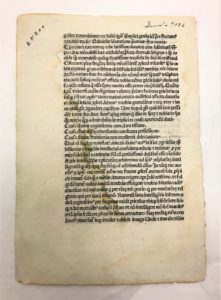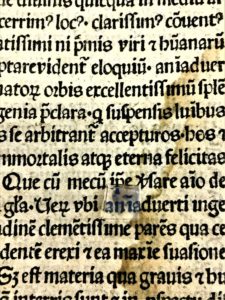The Oratio in die Omnium Sanctorum is a series of sermons written for All Saint’s Day by Thomas de Capitaneis. From the Pitts Theology Library incunabula collection, it is a small pamphlet printed in 1483 with simple paper covers. The pamphlet appears to have been partially submerged in liquid and allowed to dry. As the pamphlet dried, any dirt that was on the paper or in the liquid created a stain known as a tide line. The Emory Libraries Conservation Lab staff is working to remove this stain, as seen in the first image.
To begin, we tested the pH and the conductivity of the paper using a 5% rigid agarose gel with pH and conductivity meters. Next, we used this data to select a cleaning solution and decided upon a solution with a pH of 8.5, buffered with boric acid, and containing DTPA (di-ethylene tri-amine panta-acetic acid) to act as a chelator. The chelator bonds with the metal ions in the stain and allows them to be removed from the paper.
Our staff prepared a second rigid agarose gel, using the buffered DTPA solution. We cut small pieces of this gel and applied them directly to the stain for approximately twenty minutes. Like a small sponge, the gel chemically absorbed discoloration of the paper and allowed us to remove the stain without introducing liquid into the paper. This was particularly important, because there were water-soluble ink notations on the paper, preventing submersion in a water bath. We also needed to avoid the creation of more tide lines. In the second image, an area where the stain was reduced is evident above the gel square.
Many thanks to AIC Fellow Stephanie Watkins, an Atlanta area conservator of paper-based collections including fine art, archives, and photographic materials. Stephanie worked with us on the removal of paper-based stains using agarose gels. The Emory Libraries Conservation Lab will continue to treat this important item and document our results. Stay tuned for a future blog post with more photographs and an update to this interesting project.
Kirsten Wehner, Assistant Conservator
Emory Libraries Conservation Lab


